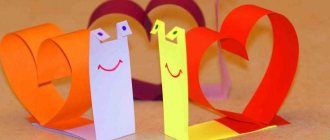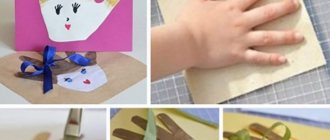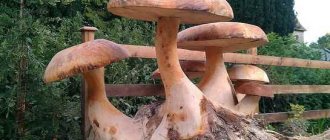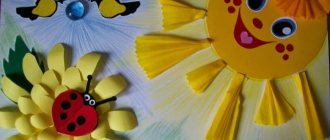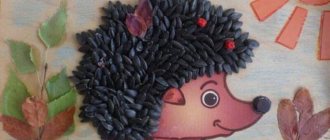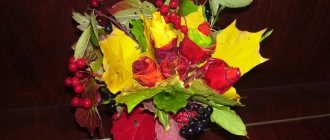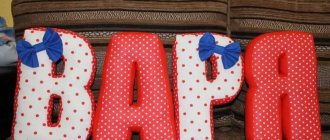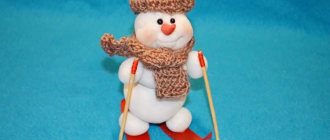When you need to make a fun and creative card or an equally original bookmark, you can’t find a better origami ice cream made from paper. It turns out that the popular delicacy is a recognized anti-stress; it contains natural tryptophan, which elevates mood, effectively resists depression, improves sleep and relieves psychological stress. The image of ice cream also evokes positive associations. Folding it using the origami technique is a real pleasure, because most of the patterns are simple and accessible even to young children.
Master class “Ice cream made from paper”
Paper ice cream can be made either simple or complex, depending on the age of the children for whom the master class is designed. An option for younger children is a cone with colored balls. The pattern for this ice cream craft consists of two parts - a “waffle” corner and a filler.
Materials and tools:
- paper - yellow or light brown, white or pink;
- glue or glue stick;
- marking pencil and scissors.
You can invite children to draw a grid in advance on a sheet of paper for the cone, imitating the texture of a waffle. This way the applique will look more elegant, and the paper ice cream craft will look more realistic. In this case, you will also need a ruler and felt-tip pens.
Technique:
- Trace the templates (corner and 6-8 circles) on paper.
- Cut out the elements, glue the horn.
- Fold the circles in half and glue them together.
- Assemble the craft.
Ice cream balls can be assembled without glue. To do this, you need to make cuts along the central part to the middle of the circle, and then insert the elements crosswise. To prevent the shape of the ball from folding inside the cup, you will have to make slits along the edges of the cone and teeth inward.
Templates
In kindergarten, children themselves cannot yet calculate and mark out the shape of a craft. The teacher should take care of the templates. Their shape depends on the selected product option. Ice cream craft can be:
- a glass - for self-production you will need walls and a bottom;
- horn - you need a shape with a rounded edge or a rectangle for the option with a corner;
- popsicle - you need dimensions for the stick and a layout to create a briquette.
The option with a plate and spoon should not be offered; not all children in the kindergarten group will be able to visualize this design option. It is less associated with ice cream.
Templates and layouts are not required if the ice cream craft is made from scrap materials - plastic cups, balls, balloons, cotton pads or napkins.
Leader of the plasticine market
The first plasticine of the Play-Doh brand was released in 1956. Since then, she has sold more than two billion jars of this wonderful modeling material. Its advantage over other types of plasticine is that it is absolutely safe, very soft and flexible, does not stick to your hands and has a wide range of bright colors. And the recipe for Play Do plasticine is kept in strict confidence. It is only known that its composition includes wheat, water and salt, i.e., in essence, it is not plasticine at all, but modeling dough.
Related article: Crocheting a top for beginners from melange yarn
Even if during classes the baby swallows a small piece of this mass, nothing bad will happen, because all the components have a natural composition, even food dyes are used to create it. But you won’t want to try it again, this plasticine tastes bitter and salty. It is packaged in a cellophane shell, which is placed in a beautiful plastic cup. The lids of the cups have a stamp that can be used to leave beautiful imprints on plasticine. She didn’t stop at producing just modeling dough; she also produces a variety of accessories for modeling: all kinds of stacks, molds, rolling pins, stamps and even entire sets.
Applications
Ice cream in the form of an applique can not only be demonstrated at an impromptu exhibition after class, but also placed on the wall. The interior decoration will be a good present for grandparents who lovingly treasure their grandson’s first creations.
As a basis for the application, you can take a sheet of cardboard or a ready-made photo frame. Older children can make a passe-partout or an impromptu frame from the same popsicle sticks themselves. Materials from which DIY ice cream can be made:
- scraps of fabric and leather;
- colored paper and cardboard;
- cereals, pasta;
- bottle caps and buttons;
- nuts and cotton pads.
The material can be used in its pure form and tinted. Gouache, which contains bright, opaque white, is suitable for tinting.
Technique for making the Button Ice Cream applique:
- Cut a triangle out of a waffle towel, tint it with brown paint, and dry it.
- Using the base, outline the shapes of the ice cream balls and divide the buttons by color.
- Glue the “horn” and buttons onto the PVA, laying out the balls in a “pyramid”.
- The background can be decorated with multi-colored beads or beads. It’s easy to make a frame out of them or buttons of a different color.
To work with bulk materials, you need to use PVA construction adhesive. It is as safe as stationery, but much thicker in consistency.
Use ready-made templates to create applications from various materials:
Spider webs for Halloween decoration
Decor and crafts made from wooden ice cream sticks look very original and stylish, with which you can decorate your home for the holiday. For the web you will need 5 sticks, which are glued together in the center, and the web is woven from woolen threads; the spider can be made from airy plasticine.
Several identical cobwebs are hung on the walls inside the house or decorated with them on the front door and window openings, maintaining the holiday atmosphere. To make a large web, you can glue several sticks together, forming diverging rays of the base from them, and after that you can work with threads.
Corrugated paper ice cream
Corrugated paper does not hold its shape, so it is used as a finish for finished parts or in the form of crumpled balls. You can cover it with cardboard or a plastic cup, ping pong balls and small balloons. Without a ready-made shape, the crepe paper simply needs to be scrunched or folded several times to form a tight stack. Crafting ice cream from corrugated paper is easy even when large. It will make a spectacular garland or Christmas tree decoration.
Materials and tools:
- thick paper for cups;
- corrugated paper of different colors;
- empty eggshell;
- PVA glue, scissors.
In order for the eggshell to become dense, after blowing out the contents, you need to hold it for 10-12 hours in salt water (2 tablespoons of salt per glass).
Performance:
- Using the templates, trace and cut out the details of the cup. Glue the form together.
- Wrap the eggshells in corrugated paper for 2-3 layers.
- Secure the paper with glue. Place the balls in the cup so that the glue is not visible.
- Cut out drops of topping and stick to the edges of the cup.
The cup itself can also be wrapped in corrugated paper. Older children can imitate the texture of a waffle by weaving paper ribbons like basket weaving or by winding them in a spiral. The cardboard must first be soaked with glue.
Why should we make craft ice cream?
It would seem, really, why? How can such a work of art be useful? Psychologists give the answer to these questions: children often use such products in subject associations, for example, as interior details in dollhouses. A bouquet of beautiful ice cream cones will be a great addition to your home decor.
Origami
Children aged 7-9 years can handle the ice cream diagram using the origami technique. You can decorate the finished craft with funny faces drawn after assembly. This will make the craft seem even more interesting. To make it, you will need a classic paper square made from a low-density A4 sheet. Smaller or stiffer paper may be difficult for your child to fold.
Waffle delicacy
An ice cream cone craft can be used in games with a child, and can also serve as a decoration for any holiday. The treat created in this way can be taken out of the cone and put back.
For the product you will need:
- 2 sheets of A4 colored paper
- For ice cream and cup, respectively.
- We make blanks of squares with sides of 15 and 10 centimeters.
We make a horn from the first blank:
- Fold the squares diagonally and immediately unfold them back. After this action, we should see a bend line in the middle of the square (from one corner to the other).
- Place the square so that the fold line is vertical to you. Next, take the right corner of the square and fold it towards the bend line.
- Then we attach the left corner to the bend line.
- We bend the upper triangle down.
- We open the resulting workpiece to the original square.
- Re-bend the upper triangle along the previous bend.
- We also align the sides along the same bend. Thus, the upper triangle is inside the figure.
- Turn the product over. The making of the horn is completed.
We make a ball from the second blank:
- Finding the center of the square. To do this, the square is folded lengthwise and then crosswise. We unfold the workpiece and see a cross in the center of the square made of bends. This is the center.
- We attach all the corners of the square to the center.
Scheme
There are several options for folding origami Ice Cream. The level of difficulty varies. The simplest options involve connecting two parts - a corner envelope and conditional balls. More complex models are one-piece crafts made from one sheet.
From cotton pads
Cotton pads are ready-made forms for simulating ice cream balls. If desired, they can be tinted by immersing them in water with a weak paint solution. For applications, the discs are left flat. but if desired, they can be fluffed up. Unmolded cotton wool can also become part of a children's craft - just roll it into tight balls.
Materials and tools:
- Cardboard for the background and cup, strips of colored paper.
- Cotton pads.
- Glue, scissors.
Additionally, you can use stencils for cherries or strawberries - decorative decorations on ice cream. Finely chopped bright paper can also be used as a topping.
Technique:
- Using the templates, we trace and cut out the parts.
- Glue large elements onto the base.
- We decorate the waffle and decorate the glass with stripes.
- Glue the topping on top of the cotton pads.
Cotton pads can be tinted not only with paint, but also with hairspray with glitter. When using the spray by children, you must follow safety precautions.
From fabric
Fabric ice cream can be made using the appliqué or soft toy technique. In the second case, based on crafts, you can teach children decorative stitches or processing the free edge. Depending on the desired result, you can use felt, suede or pieces of leather, as well as waffle fabric or light chintz.
Materials for making felt popsicles:
- 2 rectangles of light material.
- 2 pieces dark brown.
- Popsicle stick, beads, rhinestones.
- Cotton wool or flap for stuffing.
- Felt pens, thread and needle.
Children should be given a template for a decorative edge in the form of dripping drops of chocolate in advance. This will make the drops look more natural. First-graders can make rectangles with given dimensions themselves. To make them look realistic, they need to have rounded corners.
Technique:
- We cut out the blanks according to the template.
- With a pencil we outline the location of the parts (chocolate, sticks).
- Let's draw a face. For blush, blur the marker dot with cologne.
- We sew the details with drops behind the figured edge.
- We fasten the parts with stitches in a circle from the entry point of the stick.
- Before the last stitches, fill the form with stuffing and distribute it to the corners.
- We close the seams. Insert the stick.
- We use rhinestones, beads and chopped felt as decorative toppings.
Doll furniture: sun loungers, tables and chairs
If a child has a dollhouse made of cardboard, its arrangement can be supplemented with furniture made from ice cream sticks. From these materials you can make a table and stools, doll lounge chairs and benches, frames for doll mirrors and photographs, or even build a country house from them for a doll family.
It is better to start this complex project in advance by making sure that there is enough collected material to implement the ideas or by purchasing sticks for a medical examination in advance. It will not be difficult for parents to make a house using simple templates and additional materials, such as matchboxes, matches and colored cardboard, paper and thick woolen threads or jute.
When making crafts from ice cream sticks for children, you can use all acquired skills and combine material processing techniques. From such elements it is easy to assemble complex designs and compositions, useful devices and exclusive decor.
Joint creativity is an excellent solution for strengthening family relationships, and such activities will help develop imagination and perseverance in children of different ages.
From a sponge
A dish sponge is a ready-made mold for making popsicles. All you have to do is make a cut and insert the stick. If this shape seems too simple, you can make a multi-layered complex structure by cutting circles of different diameters from multi-colored sponges and gluing them together into a pyramid. You can decorate the craft with crumbly glitter and beads. The topping can easily be imitated with colored rice or semolina. To do this, the cereals need to be soaked in watercolor or gouache and dried.
Small bird feeder made from sticks
This craft can be used in finished form to decorate your own garden and local area, or hang in the courtyard of an apartment building. The design of the feeder is very simple; to assemble it you will need glue and sticks; to increase the aesthetics of the design, they can be pre-decorated.
To begin with, construct a square base from sticks, the edges of which should overlap and are fixed with glue at the joints. You can glue the sides to the base by adjusting the number of sticks, their height, and beads and seed beads, flowers or figures cut out of felt will help decorate the craft.
Made from plasticine
Modeling from plasticine is included in the compulsory curriculum in kindergarten. Using the Ice Cream master class as an example, you can learn with your children a whole range of techniques for working with the material:
- to imitate a waffle, make an impression of a towel or a relief toy;
- for balls - roll the material in your palms and on the table;
- to add texture, apply the design with stacks or toothpicks;
- To make it look like pouring horns, twist and lay the strands.
When working with soft plasticine, you can use pastry bags to create spectacular shapes.
The same steps are suitable for making souvenir Watermelon ice cream from polymer clay:
- The base is a triangle made of red plasticine.
- We make narrow flat strips from white and green.
- We lay it out along the edge and press first the white one, then the green one.
- We cut off the excess.
- We make seed droplets from black plasticine and place them on the surface.
- Stick in a popsicle stick.
Bouquets in a waffle cone
Here's another idea for holiday decor - bouquets in “waffle cones”. Such a craft will, of course, bring a lot of pleasure even at the creation stage: watching how beauty comes out of nothing is fun, exciting and great. Well, then such ice cream will delight both you and your invited guests during the holiday, and that’s great!
How to make bouquets in “waffle cones” - master class from Hellowonderful
Interesting ideas
The most unexpected materials can become materials for making crafts. When offering them to children, you need to take into account safety and accessibility. Simple tinted polyurethane foam imitates ice cream well, but adults must process it in advance. This is the only way children will be protected from harmful fumes. Safer original materials:
- popcorn (suitable for both appliques and voluminous crafts);
- pompoms made of threads and decorative ribbons;
- tulle and mesh washcloth;
- balloons and plastic unbreakable light bulbs;
- cardboard egg racks dissolved in water.
The cut out corners from the grates can also become miniature cups for cones. Elementary school children can be trusted to independently search for material. This will contribute not only to the development of fine motor skills and perseverance, but also creative thinking.
